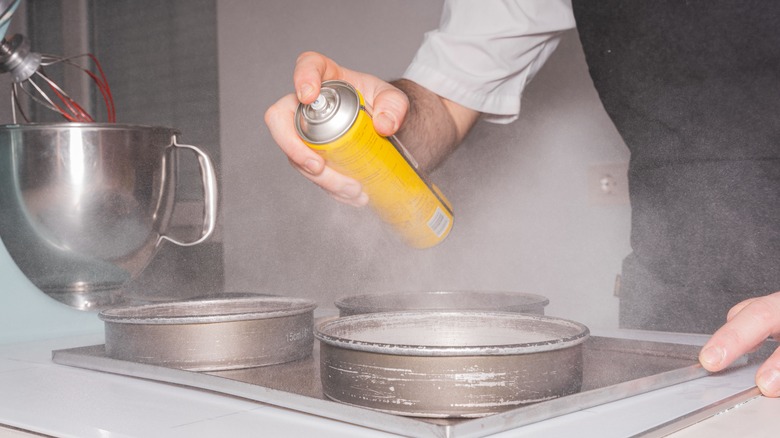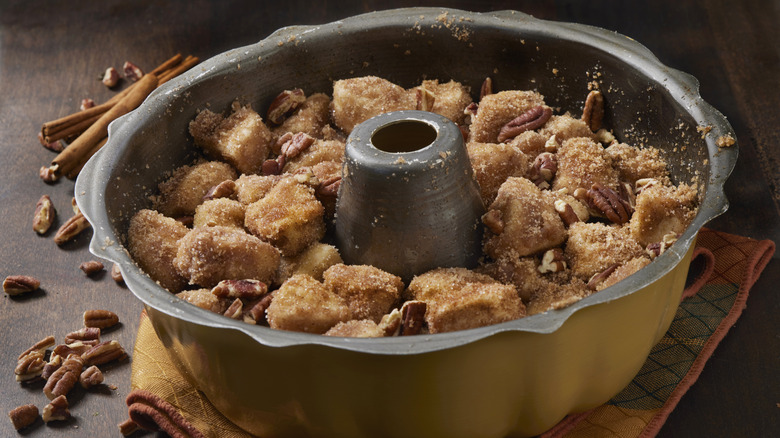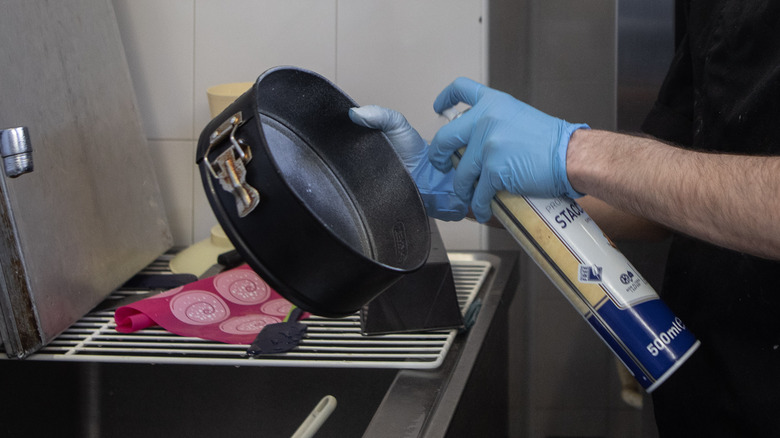Is There Even A Difference Between Cooking And Baking Spray?
Cooking spray and baking spray are just two of the many easy-to-use, push-nozzle-released varieties of aerosol fats contained in metallic cylinders to prevent stickiness, which can be found at the average supermarket. Both are offered in a variety of types, made from different oils — derived from plant-based and animal-based sources, and converted into an easily sprayable and durable form — and evoking any number of flavors. They're packaged similarly, grouped together in stores, and they're often used interchangeably, for better or for worse.
But while these two kitchen aids are mostly similar to one another, there are a few important distinctions between the two product lines. These sprays both have their benefits, and there are food-preparation scenarios to which each is individually ideally suited. However, the addition of an extra ingredient makes all the difference. Baking spray is essentially cooking spray, but along with that blend of oils, flavors, and emulsifiers is a measure of flour.
Baking spray is helpful for better baked goods
Baking spray, recommended and intended for use in baking projects, is essentially cooking spray but with the addition of flour. Similar to how dusting a work surface with raw, powdered flour aids kneading by preventing sticking, the minuscule particles of flour suspended in a blast of baking spray create another layer of protection between the metal surface of a baking vessel and pastry dough.
This imperceptible but important space dividing the flour-based dough and the metal pan not only allows for an easier, smoother release of the cooked pastry when it finishes baking, but the baking spray protects the food. Baking in a metal pan tends to make the dough cook faster and potentially burn. The more contact it has with metal, the more likely it is to burn, as metal is such an efficient conductor of heat.
Baking spray is also very good to use on a bundt pan, in whichever creative ways you utilize it, or on other baking tools with a lot of small, difficult-to-grease corners. The spray can be applied evenly and fill those areas, helping to prevent the cake from sticking when trying to release it from the pan. The tandem of flour and fat — which is what distinguishes baking spray from a cooking spray — provides a coating that makes it much easier to take a finished pastry from its pan.
Cooking spray and baking spray have a lot in common, but not everything
Cooking spray and baking spray are extremely similar. Both utilize technology to grease a pan with as little fat as possible by converting it into a mist. A can of either product typically contains a fat, a propellant (to make it all go out of the nozzle), and an emulsifier (to keep all the ingredients mixed). All of these sprays are designed to prevent food from sticking to a pan as it cooks.
Cooking spray can be used for baking, but it's not a perfect substitute. (As an important aside, know that some cooking sprays might ruin your air fryer.) To simulate the extra benefits of the flour found in baking spray, parchment paper provides another layer of protection against burning and ensuring against sticking. However, it's not a good idea to use baking spray for cooking projects. In high-heat situations, such as in range-top cooking or on a grill, the flour contained in the spray may burn and ruin the dish.
To ensure that home cooks and home bakers alike use the right product, manufacturers and recipe writers may be abundantly and redundantly clear about which spray is right for the task at hand. There's no such thing as baking spray without flour, because the flour is what differentiates cooking spray from baking spray.


